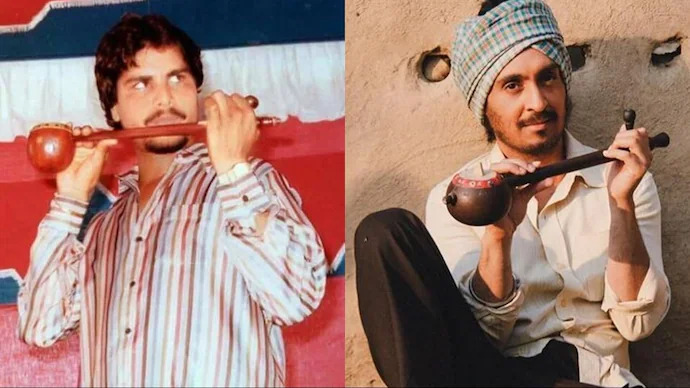
Breaking taboos: How Amar Singh Chamkila and Amarjot Kaur defied Punjabi norms through music
By Ethan Parker, October 17 2024—
The desi diaspora is all too familiar with the infamous Amar Singh Chamkila, a Punjabi singer whose impact cannot be overstated. But behind the songs we listened to while our parents weren’t around, lies a harsh but rather juxtaposing reality of the restrictions on freedom of speech prevalent in South Asian cultural dynamics.
If you aren’t familiar with Amar Singh Chamkila, for many South Asian folks, he’s like the Elvis Presley of Punjab. Amar Singh reached a great deal of success in his career and left behind a repertoire of music in the language of Punjabi. If you translated his work, you’d know the man was no stranger to innuendo with his wife, his partner in crime, Amarjot Kaur singing in high pitch melodies.
Amarjot Kaur was shot at a performance, preceeding Chamkila on March 8, 1988 by a group of men who wanted their explicit music to come to an end. The assassination of Chamkila and Amarjot Kaur is a direct testament to the restrictions on individuality and freedom of speech in South Asian society. This is an epidemic further exemplified by the assassination of Sidhu Moose Wala by unidentified assailants while occupying his vehicle in 2022 and other Punjabi singers, who chose to go down a path of eye-opening and unspoken truths about society.
Amar Singh Chamkila, the man behind Pehle Lalkare Naal, likewise is the man behind the insufferable assassination of individuality and freedom of speech. Amar Singh and Amarjot Kaur took a shot at speaking this harsh reality through their songs and through the weaponizing words they sang, came the death of sound and truth-provoking music for the next decade.
But Amar Singh and Amarjot Kaur gained further fame in 1984 during the massacre of Sikhs in Punjab at their place of worship, Harmander Sahib in Amritsar and on the streets, entailing the hate based killings of Sikhs. During these times, Amarjot and Amar were the light that Punjab needed. What the duo did was remarkable and very few have come close to singing in such manners in the Punjabi music industry, let alone the South Asian music industry. Why is it we are all thinking about such forbidden matters but singing and sharing these thoughts with the rest of the world is such a taboo?
Women in particular are told to be silent about issues they have, to keep their marriage in the bedroom and be enslaved to household duties in Punjab, that going against their husband would be a serious crime. So when Amarjot Kaur and Amar Singh took the spotlight, this enraged several threatened women and emasculated their husbands. Amar Singh not only gave our closeted and bedroom thoughts a platform to be expressed but a way for women to step outside the bedroom and damsel in distress narrative. For this matter, the boldness of the loving pair and their participation in infidelity, did not sit well with traditional Punjabi households who cared about their reputation. Listening to Chamkila and his mistress would mean they too would be associated with negative connotations in Punjab.
Therefore, the themes that Chamkila sang about were undiscussable in many households and being associated with his music would be seen in an ill manner. What is alarming is that during the 1984 Sikh genocide, when several Punjabi Sikh people were brutally killed and women were sexually assaulted, Chamkila’s music reached a peak. During times of societal wreckage and disparity, individuals turn to mediums of expression and individuality as a leisurely activity. When Sikh women were facing sexual assault on the streets of Punjab, why is it that the songs of Chamkila which reduced women to sexual matters became increasingly popular? It is rather juxtaposing to celebrate and be joyous in times of such homicide in society but why is it then people turned to Amarjot Kaur and Amar Singh?
Evidently, the rise of Chamkila and his peak during the 1984 Sikh Genocide is a testament that his music resonated with the folks of Punjab, an individual who said what we were too scared to. At a time when women in Punjab were restricted to arranged marriages and traditional female roles, Chamkila brought Amarjot Kaur to the limelight alongside him, enraging traditional Punjabi households. Not only did they express their sexual desires in their songs but they went down a rebellious streak of making their desires for alcohol known and other forbidden matters at the time. The duo paved the way for Punjabi singers today who can now to some extent sing freely about alcohol, guns, love and intimate matters.
However, even today many Punjabi and South Asian singers face the harsh reality of being openly expressive of their desires, and face challenges in confining to cultural norms and their own desires. Singers like Chamkila and Sidhu threatened certain individuals through their music, by doing what most wouldn’t, these men broke several barriers in their restricting cultures.
So why is it as fans we fall victim to this balancing act as well? We simultaneously enjoy their music and it resonates on some level but we turn it off when around judgmental elders. Unfortunately, we are victims to the confining South Asian societal norms surrounding expression of individuality. Thus experiencing suffocation pertaining to freedom of speech, and yes, the partners in crime, Amar Singh Chamkila and Amarjot Kaur, truly did make their marks as the Pehle or Pioneering Punjabi partners in crime in the households of many Punjabi families. Their prison or rather legacy was in the brutal reality of Punjab and in paving the lyrical liberation for their listeners.
This article is a part of our Voices section and does not necessarily reflect the views of the Gauntlet editorial board.
